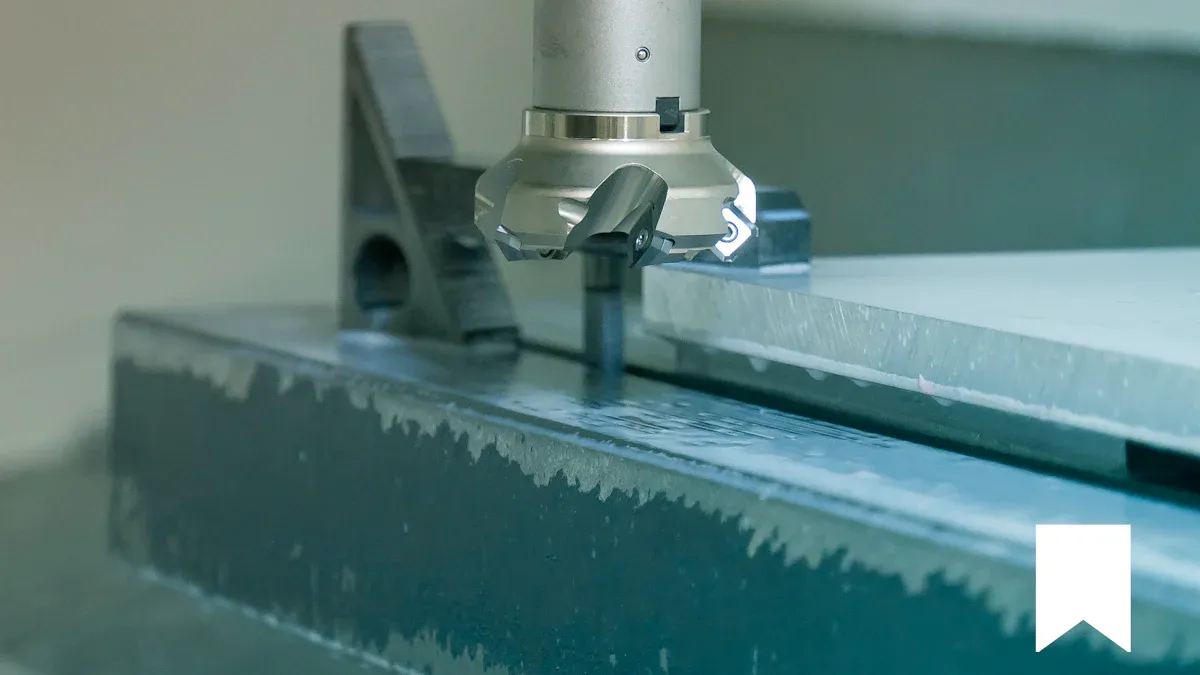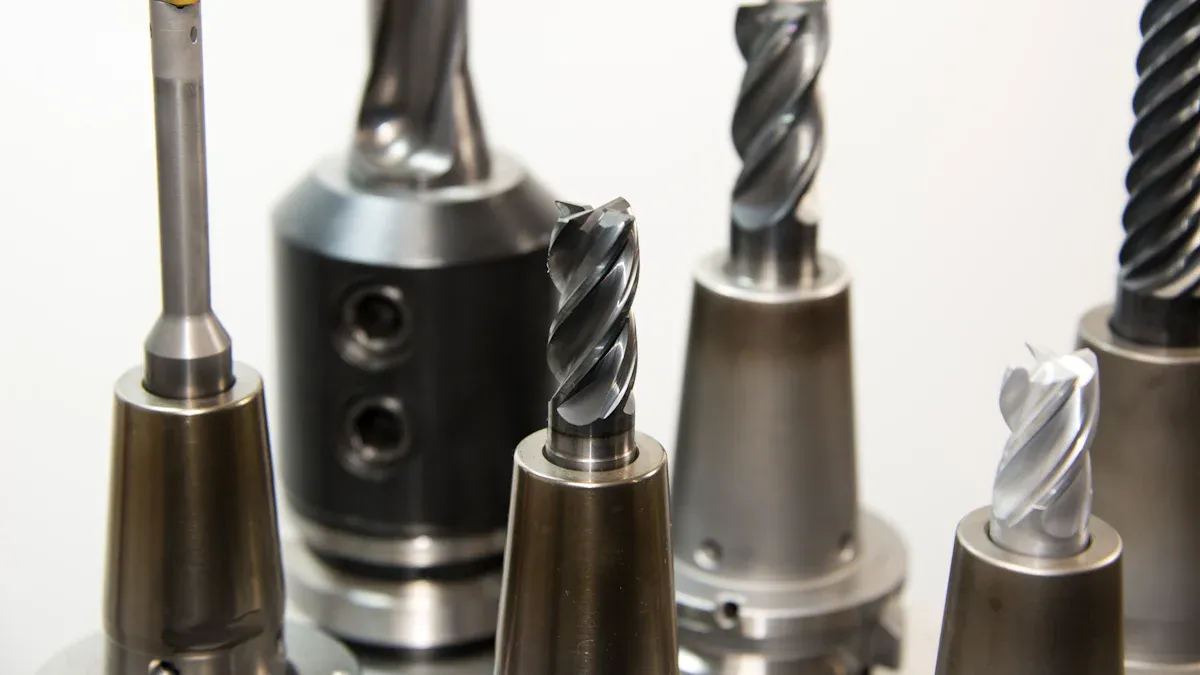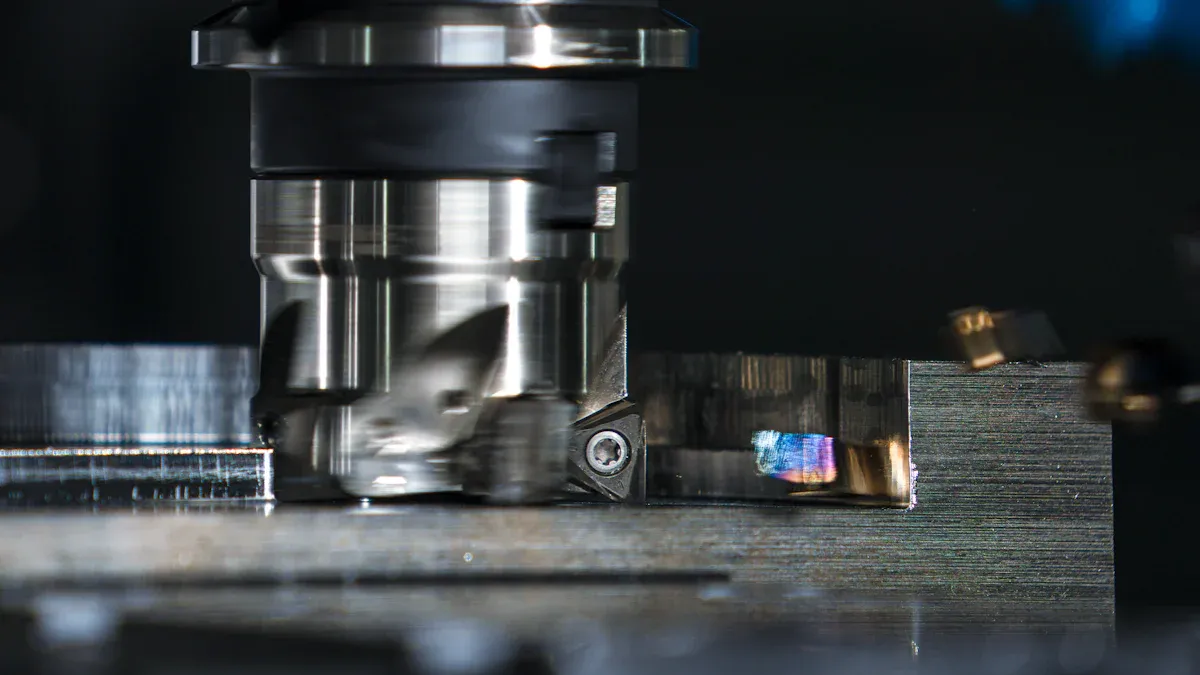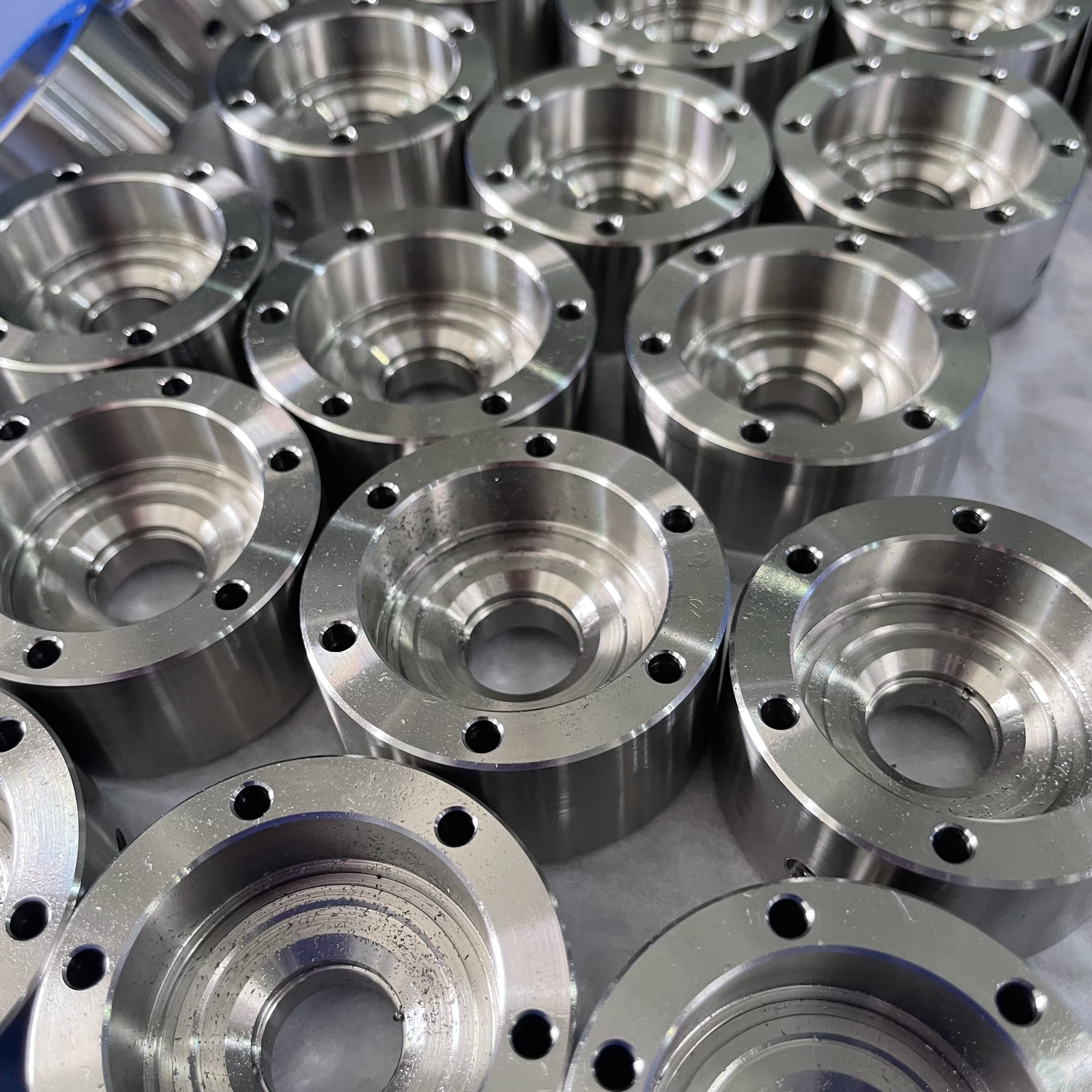Understanding the CNC Machining Process for Creating Custom Robot Components

CNC machining uses computer-controlled tools to craft precise components, making it essential for creating custom robot parts. Unlike traditional methods, CNC minimizes human error by automating processes, ensuring consistent quality. You benefit from its ability to produce parts with tight tolerances repeatedly. This efficiency and precision make CNC machining a cornerstone of modern robotics manufacturing.
Key Takeaways
CNC machines make robot parts automatically, lowering mistakes and keeping quality steady.
CAD and CAM software help design and program faster, making complex robot parts more accurate.
Choosing strong materials and keeping exact measurements are key for making tough, reliable robot parts.
What is CNC Machining?

Overview of CNC machining
CNC machining is a manufacturing process that uses computer-controlled tools to create precise and complex parts. You can rely on this process to achieve high levels of dimensional accuracy, which is essential for robotics. It works with a wide range of materials, such as metals, plastics, and composites, making it versatile for different applications. Additionally, CNC machining provides excellent surface finishes, ensuring smooth and functional robotic components.
Tip: CNC machining is ideal for producing durable and high-performing robot parts due to its precision and material compatibility.
How CNC machines work
CNC machines operate through a combination of hardware and software. The machine tools, such as the sliding table and spindle, perform cutting and shaping tasks. The sliding table moves along the X and Y axes, while the spindle controls the Z-axis for tool positioning and speed. Feedback systems, including encoders and sensors, ensure precision by monitoring position, speed, temperature, and vibration. The machine control unit (MCU) acts as the brain, managing operations like tool changes and spindle control. Input devices, such as keyboards or USB flash drives, transfer CNC programs into the machine, enabling automated production.
Applications in robotics and other industries
CNC machining plays a vital role in robotics by creating custom components with tight tolerances. Beyond robotics, you’ll find CNC machining in industries like aerospace, automotive, and healthcare. It’s also used in niche manufacturing, semiconductors, and even musical instruments. This versatility makes CNC machining a cornerstone of modern manufacturing across various fields.
Note: Industries like military, construction, and food and beverage also benefit from CNC machining’s precision and efficiency.
Benefits of CNC Machining for Custom Robot Parts
Precision and accuracy
CNC machining delivers unmatched precision, making it ideal for creating custom robotic parts. You can achieve tolerances as tight as +/- 0.0002 mm with advanced machines like Swiss lathes. This level of accuracy ensures that components fit perfectly, which is crucial for robotic systems. For example, CNC machining allows you to align moving parts and joints with exceptional precision, enhancing the robot's overall performance.
Machine Type | Precision Range |
|---|---|
CNC Robots | 0.1 to 0.2 mm |
Cutting-edge CNC | 0.02 to 0.05 mm |
Swiss Lathe Machines | +/- 0.0002 mm |
By using CNC machining, you can produce parts tailored to specific needs while maintaining tight tolerances. This capability is essential for ensuring the reliability and functionality of robotic parts.
Customization for unique designs
CNC machining empowers you to create custom cnc robot parts with unique and complex designs. Whether you need precise robot arms, gears, or enclosures, CNC machining can handle intricate geometries. For instance, it enables the fabrication of robot frames and chassis with high structural integrity. You can also produce end effectors and sensors with exact specifications, ensuring seamless interaction with the environment.
Additionally, CNC machining supports the creation of mounting brackets and housings that fit perfectly into your design. This flexibility allows you to innovate and build robots tailored to specific applications, from industrial automation to healthcare.
Efficiency in production
CNC machining streamlines production, saving you time and costs. Simplifying part designs reduces machining steps, while batch production lowers the cost per unit. By using standardized components and cost-effective materials, you can further optimize expenses. CNC machines also minimize errors, reducing the need for rework and ensuring consistent quality.
Efficient tooling strategies and lean manufacturing practices enhance productivity. For example, CNC machining allows you to produce multiple parts in a single setup, maximizing machine time. This efficiency makes it a reliable choice for manufacturing custom robotic parts at scale.
Steps in the CNC Machining Process

Designing with CAD software
Designing robotic parts begins with CAD (Computer-Aided Design) software. This tool allows you to create detailed 3D models of your components. These models help you visualize and refine designs before production, ensuring dimensional accuracy and functionality. For example, you can test how parts will fit together or simulate their performance in a virtual environment. This step minimizes errors and ensures precision in the final product.
To design effectively, follow these steps:
Ensure all dimensions are accurate to avoid assembly issues.
Use templates to plan layouts before cutting materials.
Begin constructing parts using CNC machines or hand tools.
Test fit components and make adjustments for proper alignment.
By starting with CAD software, you set the foundation for successful CNC machining processes.
Programming with CAM software
Once your design is ready, you’ll use CAM (Computer-Aided Manufacturing) software to program the CNC machine. CAM software automates the machining process, making it efficient and precise. It identifies features in your CAD model and generates toolpaths for cutting or shaping materials. This automation reduces the effort required for complex jobs and speeds up production.
Using CAM software offers several advantages:
Higher efficiency through streamlined processes.
Faster project turnaround with automated programming.
Better control over manufacturing tasks.
Reduced training time for new operators.
With CAM software, you can handle intricate designs and maintain tight tolerances with ease.
Material selection
Choosing the right material is crucial for creating high-performing robotic parts. CNC machining supports a variety of materials, including metals and plastics. Strong and stiff materials, such as aluminum or stainless steel, are ideal for structural components. Plastics like ABS or polycarbonate work well for lightweight parts or enclosures.
CNC machining excels in producing custom parts for specialty applications. It also allows for rapid prototyping and low-volume production. By selecting the appropriate material, you ensure your parts meet the required strength, durability, and precision.
Machining and finishing
The machining stage involves cutting, shaping, and refining your material to match the design. During this step, you must consider factors like workholding and stiffness to prevent vibrations and maintain accuracy. Optimizing toolpaths reduces machining time and ensures efficient material removal.
Finishing processes, such as spotfacing or chamfering, improve the quality and functionality of your parts. Spotfacing ensures bolts or fasteners sit properly, while chamfers enhance assembly and aesthetics. Maintaining sufficient wall thickness prevents vibrations and ensures precise dimensions. These considerations help you achieve the desired precision and quality in your robotic parts.
Key Factors for CNC Machining Robot Components
Material considerations
Selecting the right material is critical for creating durable and functional robotic parts. Each material offers unique properties that influence machinability, strength, and cost. For example, aluminum is easy to machine and provides good strength, making it a popular choice for lightweight components. Stainless steel, while harder to machine, offers excellent corrosion resistance and durability. Titanium is ideal for high-performance applications due to its strength and resistance to extreme conditions, though it is expensive.
Here’s a quick comparison of common materials used in CNC machining:
Material | Machinability | Corrosion Resistance | Strength Characteristics | Cost Comparison |
|---|---|---|---|---|
Aluminum | Easy | Moderate | Good | About twice that of steel for small components |
Stainless Steel | Difficult | High | Similar to carbon steel | 2-3 times that of carbon steel |
Titanium | Difficult | Extremely high | Very high | Very expensive |
Copper Alloys | Varies | Good | Moderate | 4-5 times that of carbon steel |
Brass/Bronze | Easy to difficult | Varies | Lower than steel | 4-5 times that of carbon steel |
Choosing the right material ensures your robotic parts meet the required strength, precision, and cost-efficiency.
Tolerances and accuracy
Tolerances and accuracy are vital for CNC machining robotic parts. High-precision components ensure that moving parts, such as joints and actuators, align perfectly. Even minor deviations can affect the robot’s performance. CNC machining excels in maintaining tight tolerances, which guarantees consistent dimensional accuracy across multiple parts.
Key benefits of precise tolerances include:
High-Precision Parts: Perfect alignment of robot joints and moving components.
Tolerance Control: Exact dimensions for reliable performance.
Repeatability: Consistent production of identical parts for seamless assembly.
By focusing on tolerances and accuracy, you can enhance the reliability and functionality of your robotic systems.
Design complexity
Complex designs often pose challenges during CNC machining processes. Producing intricate geometries, such as thin walls or detailed features, requires advanced tools and strategies. For instance, machining parts with tight tolerances or working with difficult materials demands precise calibration and high-quality cutting tools.
Here’s how you can address common challenges:
Challenge | Solution |
|---|---|
Producing complex geometries | Utilize advanced CAD/CAM software to simulate and modify designs before production. |
Achieving tight tolerances | Regularly calibrate CNC machines and use high-quality cutting tools to improve precision. |
Machining parts with thin walls | Adjust cutting parameters and reinforce critical areas to prevent deformation. |
Working with difficult materials | Select appropriate cutting tools and optimize strategies to mitigate issues. |
Ensuring integration with other parts | Implement precision measuring tools and adopt modular design principles for seamless fitting. |
By addressing these challenges, you can create robotic parts with intricate designs while maintaining dimensional accuracy and precision.
Choosing the Right CNC Machining Service
Evaluating expertise in robotics
When selecting a CNC machining service, you should prioritize expertise in robotics. A reliable service must demonstrate engineering skills to tackle complex designs for robotic parts. Their team should also possess logic expertise to handle CNC robotics programming, ensuring smooth and efficient operations. Collaboration with robotics suppliers is another key factor. This partnership helps integrate robotics into CNC machining processes, resulting in better precision and functionality.
Tip: Look for a service with a proven track record in manufacturing precision robotic components to ensure high-quality results.
Assessing technology and equipment
Advanced technology and equipment play a crucial role in CNC machining for robotics. Modern CNC systems enhance productivity and efficiency, especially when integrated with robotics. For example, automated CNC equipment combined with industrial robots can perform complex tasks with greater accuracy and consistency. This integration reduces human error and speeds up production. Articulated robots further improve flexibility, making it easier to manufacture intricate robotic parts.
When evaluating a service, check if they use the latest CNC robotics technology. This ensures your project benefits from cutting-edge advancements, such as faster production times and improved manufacturing precision.
Checking reviews and certifications
Certifications and reviews provide valuable insights into a CNC machining service's reliability. Look for certifications like ISO 9001, which focuses on quality management, or AS9100, tailored for aerospace manufacturing. If your project involves medical robotics, ISO 13485 ensures compliance with strict quality standards. Positive reviews from clients in the robotics industry also indicate a service's ability to deliver precise and high-quality robotic parts.
Note: Certifications and reviews reflect a service's commitment to quality and customer satisfaction, making them essential factors in your decision.
CNC machining plays a vital role in robotics manufacturing by ensuring precision, efficiency, and flexibility. You can rely on it to produce critical components like robot arms, gears, and sensors with exceptional accuracy.
The long-term benefits include reduced waste, cost-effectiveness, and consistent quality. Although the initial investment may seem high, the savings in labor and production speed make it worthwhile.
Choosing a reliable CNC service ensures your custom robot components meet strict tolerances and perform flawlessly.
FAQ
What types of materials can CNC machines process for robot components?
CNC machines can process metals like aluminum, stainless steel, and titanium. They also handle plastics such as ABS and polycarbonate, offering flexibility for different robotic applications.
How do tolerances affect robotic part performance?
Tight tolerances ensure precise alignment of moving parts, improving functionality and reliability. Even small deviations can disrupt performance, making accuracy essential for robotic systems.
Can CNC machining handle complex robotic designs?
Yes, CNC machining excels at producing intricate geometries. Advanced CAD/CAM software and high-quality tools allow you to create detailed and unique robotic components with precision.
Tip: Always consult with your CNC service provider to confirm their capability to handle your specific design complexity.
See Also
A Beginner's Guide to CNC Machining for Component Production
Exploring Key Processes in CNC Precision Machining Techniques
Achieving Expertise in CNC Machining for Precision Components
Unveiling the Secrets of CNC Programming for Precision Parts
About US
Follow Us
Your prototype holds unparalleled significance, and we deeply value its uniqueness. Collaborating with you during the preparation phase for running your prototype or parts is a commitment we gladly embrace. Whether it's a single part or a complex assembly, we are dedicated to selecting the optimal tools and pathways to bring your envisioned product to life.
At Precision Fab CNC Machining, we specialize in producing parts for prototypes, short runs, and high-volume production. Our prototyping machine capabilities extend across metal, plastic, and wood machining, with welding fabrication services available to complement and finalize your prototype if required.
Address
Address: Room320 10F, Building A,Nanshan international building, Dayawan District, Huizhou, Guangdong, 516001 China
Contacts
billy@timaycnc.com

